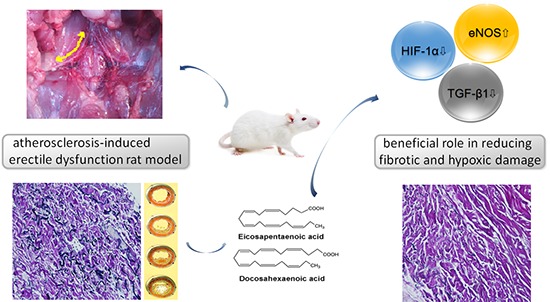- Record: found
- Abstract: found
- Article: found
Effects of Omega-3 Fatty Acids on Erectile Dysfunction in a Rat Model of Atherosclerosis-induced Chronic Pelvic Ischemia

Read this article at
Abstract
The aim of this study was to investigate whether the omega-3 fatty acids help to improve erectile function in an atherosclerosis-induced erectile dysfunction rat model. A total of 20 male Sprague-Dawley rats at age 8 weeks were divided into three groups: Control group (n = 6, untreated sham operated rats), Pathologic group (n = 7, untreated rats with chronic pelvic ischemia [CPI]), and Treatment group (n = 7, CPI rats treated with omega-3 fatty acids). For the in vivo study, electrical stimulation of the cavernosal nerve was performed and erectile function was measured in all groups. Immunohistochemical antibody staining was performed for transforming growth factor beta-1 (TGF-β1), endothelial nitric oxide synthase (eNOS), and hypoxia inducible factor 1-alpha (HIF-1α). In vivo measurement of erectile function in the Pathologic group showed significantly lower values than those in the Control group, whereas the Treatment group showed significantly improved values in comparison with those in the Pathologic group. The results of western blot analysis revealed that systemically administered omega-3 fatty acids ameliorated the cavernosal molecular environment. Our study suggests that omega-3 fatty acids improve intracavernosal pressure and have a beneficial role against pathophysiological consequences such as fibrosis or hypoxic damage on a CPI rat model, which represents a structural erectile dysfunction model.
Graphical Abstract

Related collections
Most cited references21
- Record: found
- Abstract: found
- Article: not found
Long chain omega-3 fatty acids and cardiovascular disease: a systematic review.
- Record: found
- Abstract: found
- Article: not found
Histological alterations in cavernous tissue after radical prostatectomy.
- Record: found
- Abstract: found
- Article: not found
